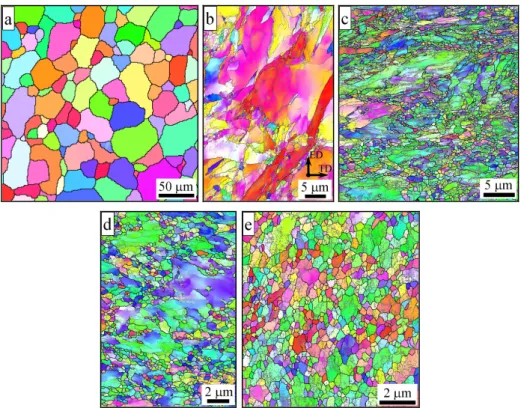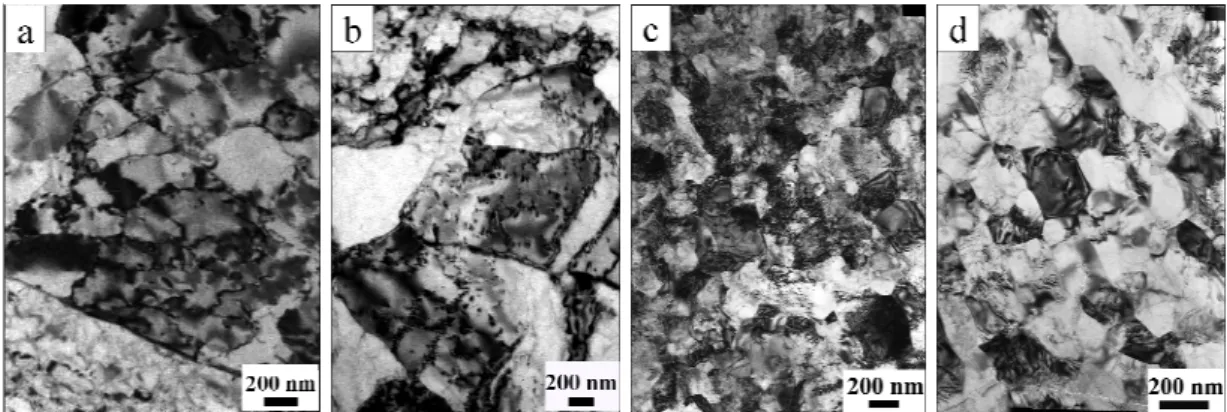HAL Id: hal-01518050
https://hal.univ-lorraine.fr/hal-01518050
Submitted on 4 May 2017HAL is a multi-disciplinary open access archive for the deposit and dissemination of sci-entific research documents, whether they are pub-lished or not. The documents may come from teaching and research institutions in France or abroad, or from public or private research centers.
L’archive ouverte pluridisciplinaire HAL, est destinée au dépôt et à la diffusion de documents scientifiques de niveau recherche, publiés ou non, émanant des établissements d’enseignement et de recherche français ou étrangers, des laboratoires publics ou privés.
Microstructure and mechanical properties of continuous
equal channel angular pressed Titanium
G S Dyakonov, C. F. Gu, Laszlo S. Toth, R. Z. Valiev, I P Semenova
To cite this version:
G S Dyakonov, C. F. Gu, Laszlo S. Toth, R. Z. Valiev, I P Semenova. Microstructure and mechanical properties of continuous equal channel angular pressed Titanium. 6th International Conference on Nanomaterials by Severe Plastic Deformation, Jun 2014, Metz, France. pp.012067, �10.1088/1757-899X/63/1/012067�. �hal-01518050�
This content has been downloaded from IOPscience. Please scroll down to see the full text.
Download details:
IP Address: 193.54.91.144
This content was downloaded on 04/05/2017 at 09:29
Please note that terms and conditions apply.
View the table of contents for this issue, or go to the journal homepage for more 2014 IOP Conf. Ser.: Mater. Sci. Eng. 63 012067
(http://iopscience.iop.org/1757-899X/63/1/012067)
You may also be interested in:
Microstructure evolution in a Cu-Cr-Zr alloy during warm intense plastic straining R Mishnev, I Shakhova, A Belyakov et al.
Twinning induced nanostructure formation during cryo-deformation M Klimova, G Dyakonov, S Zherebtsov et al.
Influence of UFG structure formation on mechanical and fatigue properties in Ti-6Al-7Nb alloy V V Polyakova, V N Anumalasetty, I P Semenova et al.
Effect of multiaxial forging on microstructure and mechanical properties of Mg-o.8Ca alloy N Yu Yurchenko, N D Stepanov, G A Salishchev et al.
Characterization of ultrafine grained Cu-Ni-Si alloys by electron backscatter diffraction I Altenberger, H A Kuhn, M Gholami et al.
Contribution of shear deformation to grain refinement and densification of iron powder consolidated by high pressure torsion
Y J Zhao, R Massion, T Grosdidier et al.
Tensile behavior of an austenitic stainless steel subjected to multidirectional forging M Tikhonova, J Sorokopudova, E Bondareva et al.
Effect of multidirectional forging and equal channel angular pressing on ultrafine grain formation in a Cu- Cr-Zr alloy
I Shakhova, A Belyakov and R Kaibyshev
Microstructure of titanium deformed by warm extrusion with forward- backward rotating die K Sztwiertnia, A Morawiec, M Bieda et al.
1
Microstructure and mechanical properties of continuous
equal channel angular pressed Titanium
Dyakonov G S1, Gu C F2,Toth L S3,4, Valiev R Z1,5, Semenova I P1
1
Ufa State Aviation Technical University, Ufa, Russia
2
School of Materials Science and Engineering, UNSW Sydney, NSW 2052, Australia
3
Laboratory of Excellence on Design of Alloy Metals for low-mass Structures (DAMAS),
Université de Lorraine, France
4
Laboratoire d'Etude des Microstructures et de Mécanique des Matériaux (LEM3),UMR 7239, CNRS / Université de Lorraine, F-57045 Metz, France
5
Laboratory for Mechanics of Bulk Nanostructured Materials, Saint Petersburg State University, Universitetsky pr. 28, 198504, Peterhof, Saint Petersburg, Russia Email: dgr84@mail.ru
Abstract Applying a continuous equal channel angular pressing technique (ECAP-Conform),
this work deals with the structure transformation and mechanical properties of a Grade 4 Ti. The microstructure evolution and mechanical properties were studied using electron backscatter diffraction; transmission electron microscopy and tensile tests. The results demonstrated that the microstructure evolution is ensured by the formation of low-angle deformation-induced boundaries during the initial stages of ECAP-Conform. With the number of ECAP-Conform passes increasing up to 10, a structure with an average grain size of 0.22 µ m was achieved, and the ultimate strength increased 1.5 times higher with respect to the initial state.
1. Introduction
Microstructure evolution in metallic materials during severe plastic deformation (SPD) and their mechanical properties have been the subject of research during the last decades. The SPD technique allows achieving high accumulated strains without material failure and enhancing its mechanical characteristics [1].
Governed by the development of deformation-induced grain boundaries, the microstructure evolution in metallic materials during cold deformation display special features. There are incidental dislocation boundaries (IDBs) formed by the trapping of glide dislocations; such boundaries have low-angle disorientations (<5°), to which, for example, cell boundaries could be related. Geometrically necessary boundaries (GNBs) are another type of boundaries with high-angle disorientations (>5°). They separate crystallite domains in which different slip systems are active [2]. It should be noted that most studies on the evolution of the grain structure and deformation-induced boundaries during deformation were conducted in metals with bcc and fcc lattices and to a much lesser extent in metals with hcp lattices. Besides, the microstructure evolution in metals with hcp lattice is controlled by a competition
6th International Conference on Nanomaterials by Severe Plastic Deformation IOP Publishing IOP Conf. Series: Materials Science and Engineering 63 (2014) 012067 doi:10.1088/1757-899X/63/1/012067
Content from this work may be used under the terms of theCreative Commons Attribution 3.0 licence. Any further distribution of this work must maintain attribution to the author(s) and the title of the work, journal citation and DOI.
2
2. Experimental
The starting Ti Grade 4 was a recrystallized coarse-grained structure (impurities in wt % were less than: 0.16 Fe, 0.1 Si, 0.05 C, 0.015 N, 0.01 H, 0.34 O). Billets of the initial Ti Grade 4 were machined to a bar with dimension of 11 mm × 11 mm × 1000 mm and were processed by a continuous equal channel angular pressing (ECAP-Conform) using route Bc up to 10 number of passes at Т=200°С. The forward speed was 5 mm/s and colloidal graphite was used for lubricant (Fig. 1). The angle of channels intersection in the ECAP-Conform die-set was 120°, so the von Mises equivalent strain in one pass was about 0.7.
Figure 1. ECAP-Conform scheme showing the orientation of the studied surface.
The microstructure was examined on the EP-extrusion plane (Fig. 1) using a JEOL 6500 FEG SEM scanning electron microscope equipped with Electron Back Scattering Diffraction (EBSD ) measurement and a transmission electron microscope (TEM). Prior to EBSD, the longitudinal section (ND-ED) of the samples were mechanically ground and polished to 1 µm grade using SiC paper and DP suspension, and then electro-polished in a chemical solution of 20% perchloric acid and 80% methanol at 30V with 20s at ~20°. EBSD characterization was carried out under an operating voltage of 20 kV and a probe current of about 5 mA with a working distance of 20 mm. Due to the fine structure of Ti after deformation, a step size of 30 nm was chosen, the scanning area was ~10 µm by ~20 µm and low and high-angle boundaries were depicted in grey and black lines, respectively (Fig. 2). The grain boundaries were identified using a minimum disorientation angle of 5° between adjacent pixels. For the data analysis, a clean-up procedure was employed in which the orientation of non-indexed pixels were replaced with one of their neighbor’s orientation. Post analysis of the orientation maps was performed using functions written in Matlab. A JEOL JEM-2100FX was used to visualize the deformed microstructure. Mechanical tensile tests were conducted on flat samples taken in the EP plane with an Instron machine at room temperature and at a strain rate of 10-3 s-1.
3. Results and discussion
The initial microstructure consisted of recrystallized grains with an average size of 10 µm (Fig. 2a). For samples which had been processed for more than one ECAP-Conform passes, a band-line lamellar structure was found in the microstructure of the two and four pass Ti (Fig. 2b and 2c) with the long axis parallel to macro-shear direction imposed by the ECAP-Conform process.
3
Figure 2. Representative microstructures of Ti Grade 4 in an inverse pole figure map by EBSD: a) initial state; after b) two passes; с) four passes; d) eight passes; e) 10 passes of ECAP-Conform. Grain
boundaries with disorientations larger than 15° are depicted by black lines.
After two and four passes the disorientation distribution skewed towards low angles, and the grain size was about 0.6 µm and 0.4 µm, respectively. The average subgrain size for two passes was 0.22 µm (Fig. 2b and 2c). The high-angle boundary fraction was ~35% for two passes and ~44% for four passes. After eight and 10 passes, the deformed Ti was comprised of a mixture of equiaxed and elongated substructures (Fig. 2d and 2e). Both grain structures have a large fraction of high-angle boundaries (47% and 60%, respectively) with an average grain size of 0.24 µm and 0.2 µm. In align with the literature results on microstructure evolution [2, 3], additional deformation results in growth of subgrain disorientations and transformation of low-angle boundaries to high-angle boundaries, as well as a reduction of the average grain size (Fig. 3). We found that the structure becomes finer and more homogeneous after 10 ECAP-Сonform passes (Fig. 2e), and substructure development is visible in grains with a size of 1 µm or more (Fig. 3).
Figure 3. Average grain/subgrain size as a function of strain during ECAP-Conform of Ti. The TEM results displayed in Fig. 4 agree well with the EBSD observations. During the first two passes the formation of dislocation walls and low-angle boundaries (Fig. 4а) are the dominating
6th International Conference on Nanomaterials by Severe Plastic Deformation IOP Publishing IOP Conf. Series: Materials Science and Engineering 63 (2014) 012067 doi:10.1088/1757-899X/63/1/012067
4
more homogeneous and a large number of fragments has wide and not well defined boundaries, which implies low-angle disorientations (Fig. 4с). Finer grains with a size of about 0.2 µm display a fairly low dislocation density and thin boundaries, possessing high-angle disorientations with their neighbors. After 10 deformation passes, the structure changes qualitatively and the sizes of structural elements decrease (Fig. 3). The number of fine grains with thin boundaries increases. The dislocation density changes markedly. A large number of almost equiaxed dislocation-free grains are observed. Similar structure changes usually take place during recovery and continuous dynamic recrystallization processes [1, 3]. Similar to the Refs. [4, 5], possibility for recrystallization and local migration of grain boundaries can happen at relatively low temperatures in the condition of high stresses (stress-induced boundary migration).
Figure 4. TEM images of Ti Grade 4 after a) two passes; b) four passes; c) eight passes; d) 10 passes. The disorientation changes were characterized by the evolution of the fraction of high to low-angle boundaries during ECAP-Conform Ti. The fraction of low angle boundary is increasing up to 65% after the first two ECAP-Conform passes (Fig. 5a), in align with the observations from the EBSD (Fig. 2b) and TEM results (Fig. 4a). We assume that the formation of subgrains with low-angle disorientations is the dominant grain fragmentation mechanism during the first two ECAP-Conform passes. With increasing strain, the fraction of low angle boundaries is reduced, so that after 10 passes it is 48%. Such tendency in microstructure evolution and in change of the fraction of low angle boundaries during severe plastic deformation is typical [9, 13]. A decrease of the fraction of low angle boundaries is connected with the gradual increase of fragments/subgrains disorientations and their transition to high angle grain boundaries (Fig. 5b).
5
Figure 5. The fraction of low angle boundaries (a) and high angle boundaries (b) as a function of strain during ECAP-Conform Ti Grade 4.
Turning into the mechanical properties of Ti Grade 4, the as-received coarse grained Ti had a relatively low strength, whereas the ECAP-Conform samples showed an increase in strength and elongation (Fig. 6).
Figure 6. Yield stress (YS), the ultimate tensile strength (UTS) and relative elongation (δ) for Ti Grade 4 samples subjected to different number of ECAP-Conform passes.
The ultimate tensile strength value increased 1.5 times from 760 MPa in the initial state to 1140 MPa after 10 passes. The maximum or peak stress is achieved after 10 passes; however, there is a relatively high elongation after eight passes (~18%-20%). The increment of the strength characteristics (ultimate tensile strength and yield stress) in the range of 2-8 passes is a consequence of subgrains and fragmentation, i.e. by structural strengthening. Some increment of high-angle boundaries after 10 passes provides enhancement of the ultimate tensile strength. However, the ductility characteristics reduce from 29 % in the initial state to 12.5 % after 10 passes (Fig. 6). The ductility reduction after 10 passes confirms the general tendency observed during structural refinement in large strain plastic deformation [6, 7] and is attributed by a high dislocation density and increased density of low and high-angle boundaries, which are effective barriers for gliding dislocations. The increased strength of Ti Grade 4 after ECAP-Conform is comparable with the properties of the doped two-phase Ti-6Al-4V alloy. Thus, it follows from the results of our study on mechanical properties and microstructure that the application of Conform solves the problem of low strength in commercially pure Ti. ECAP-Conform is a promising process for small-batch production of high-strength Ti with ultrafine-grained structure.
4. Summary
Our results lead to important information on microstructural evolution of ECAP-Conform processed Ti Grade 4 which was gained from a combination of EBSD and TEM observations. The change of the fraction of low and high-angle boundaries in Ti during ECAP-Conform has been analyzed quantitatively. It has been established that using ECAP-Conform in the given temperature and deformation conditions the microstructure evolution in the first two passes of ECAP-Conform is characterized by the formation of low-angle boundaries. Increase of the fraction of high-angle boundaries in subsequent passes was provided by an enhancement of disorientations of the deformation-induced boundaries. It was shown that after eight and 10 ECAP-Conform passes at Т=200°С, both coarse and fine grained deformation structures displayed a large fraction of high-angle boundaries (47% and 52%, respectively) with an average grain size of 0.24 µm and 0.2 µm, respectively.
Due to the evolution of the microstructure during processing good strengthening was obtained after eight passes. The UTS increased 1.5 times from 760 MPa in the initial state to 1140 MPa after 10
6th International Conference on Nanomaterials by Severe Plastic Deformation IOP Publishing IOP Conf. Series: Materials Science and Engineering 63 (2014) 012067 doi:10.1088/1757-899X/63/1/012067
6
Grant No 14.B25.31.0017), and by the French State program “Investment in the future” operated by the National Research Agency (ANR) ANR-11-LABX-0008-01, LabEx DAMAS. CFG acknowledges ARC DECRA scheme, DE130100274.
References
[1] Valiev RZ, Zhilyaev AP, Langdon TG, 2014 Bulk Nanostructured Materials: Fundamentals and Applications (John Wiley, Hoboken, New Jersey, USA, and TMS) p 456.
[2] Toth LS, Estrin Y, Lapovok R, Gu C.F, 2010 Acta Materialia V 58 p 1782–1794.
[3] Humphreys F, Hatherly M, 2004 Recrystallization and related annealing phenomena 2nd ed Oxford: Elsevier p 574.
[4] Molodov DA, Ivanov AV, Gottstein G, 2007 Acta Mater 55 p 1843-1848. [5] Winning M, Rollet AD, 2005, Acta Mater 53 p 2901.
[6] Zherebtsov SV, Dyakonov GS, Salem AA, Sokolenko VI, Salishchev GA, Semiatin SL, 2013 Acta Mater 61 p 1167.
[7] Morrison VB, Miller RL, Burke JI, Weiss V, 1970 Ultra-fine grained metals Syracuse University Press, Syracuse, New-York p 190.


